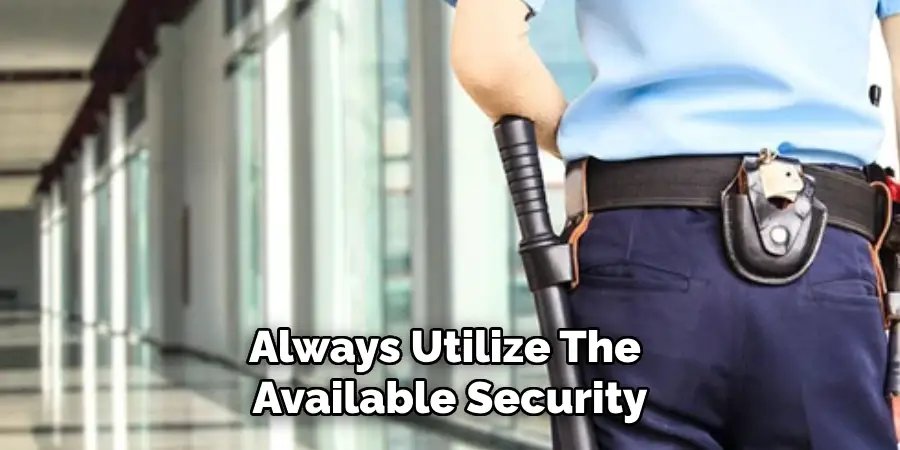Securing a hotel room door with an ironing board may seem unconventional, but in certain situations, it can provide an additional layer of security and peace of mind.

While hotel rooms typically come equipped with standard door locks, travelers may feel the need for added security, especially in unfamiliar or potentially unsafe environments.
This article aims to provide a comprehensive guide on how to secure hotel door with ironing board. Using an ironing board to secure the door involves wedging it firmly against the doorknob and floor, effectively barricading the door and making it more difficult for unauthorized individuals to gain entry.
This makeshift door stopper can serve as a temporary solution in situations where the room’s existing security measures feel insufficient. However, it’s important to remember that this method may not be foolproof and should not replace the use of proper door locks or other security precautions.
This article explores the practicalities and considerations of using an ironing board to secure a hotel room door, offering insights into when and how to implement this strategy responsibly.
The Importance of Hotel Room Security
Ensuring the security of your hotel room is paramount, especially when traveling. A secure hotel room is not only a sanctuary for rest but also a safeguard for your personal belongings and sensitive information. Hotel rooms, despite their seemingly secure nature, can be a target for theft or unauthorized access.
The importance of hotel room security extends beyond just physical safety; it encompasses peace of mind and the ability to enjoy your travels without undue stress.

Effective security measures can deter potential intruders, reduce the risk of theft, and provide a sense of reassurance. Travelers are encouraged to always utilize the available security features in their rooms, such as deadbolts, security chains, and electronic safes.
Additionally, being vigilant about safeguarding key cards and not advertising your room number can prevent accidental breaches of security. In essence, hotel room security is an integral aspect of travel safety, enabling travelers to feel secure and focus on creating memorable experiences.
Common Concerns About Hotel Room Safety
Travelers often have several common concerns regarding the safety of their hotel rooms. One primary worry is unauthorized access, where intruders could potentially enter the room due to faulty door locks or lost key cards. This can lead to theft of personal belongings or, in worst-case scenarios, endanger personal safety.
Another concern is the risk of hidden cameras or listening devices, which can violate privacy and compromise sensitive information. Guests are also wary of the cleanliness and hygiene of the room, fearing that improperly sanitized spaces can lead to health issues.
Furthermore, emergency situations, such as fires or medical emergencies, can be particularly distressing if the hotel lacks adequate safety protocols or if emergency exits are not clearly marked.

To mitigate these concerns, travelers should look for hotels with robust security measures, such as 24/7 security personnel, surveillance cameras, and well-maintained facilities. Reading reviews and choosing reputable hotels can also provide a sense of assurance regarding room safety and overall hotel quality.
Assessing Hotel Room Security Risks
When it comes to evaluating the security risks of a hotel room, travelers should adopt a thorough and proactive approach. One of the first steps in assessing security is inspecting the room’s locking mechanisms.
Ensure that the deadbolt, security latch, and peephole are functional and provide adequate security. Check for any signs of tampering or wear that might indicate the lock is compromised. Additionally, verify that the room’s windows are secure and equipped with locks, especially if the room is on a lower floor.
Another critical aspect to consider is the location of your room. Rooms near emergency exits or on the ground floor can be more vulnerable to unauthorized entry. Opting for a room on a higher floor can reduce this risk, although it’s essential to balance this with the ability to evacuate quickly in case of an emergency.
Moreover, assess the presence of security features such as electronic safes for storing valuables, functional smoke detectors, and clear signage for emergency exits. Take note of any security cameras in the hallways and common areas, which can serve as a deterrent to potential intruders.
Engaging with hotel staff can also provide insights into the establishment’s security measures. Don’t hesitate to ask about their protocols for lost key cards, emergency response, and general safety tips. Staff should be trained to assist guests with security concerns and provide reassurance about the measures in place.

By taking these steps, travelers can better gauge the safety of their hotel room, identify potential vulnerabilities, and take appropriate precautions to mitigate risks, ensuring a secure and worry-free stay.
Identifying Potential Threats to Personal Safety
Understanding and identifying potential threats to personal safety while staying in a hotel can empower travelers to take necessary precautions.
One of the most common threats is unauthorized entry, which can result from lost key cards, malfunctioning locks, or inadequate security protocols. Personal belongings left unattended or unsecured in the room are at risk of theft, particularly valuables such as electronics, passports, and cash.
Another significant threat is the presence of hidden surveillance devices. Although rare, cases of hidden cameras or bugs being discovered in hotel rooms have been reported, compromising guests’ privacy and safety.
Health hazards also pose a threat to personal safety. Poorly cleaned rooms can harbor bacteria, viruses, and pests such as bed bugs, which can cause illness or discomfort. Additionally, inadequate fire safety measures—such as non-functional smoke detectors, blocked emergency exits, or lack of fire extinguishers—can escalate the danger in the event of a fire.
Natural disasters, such as earthquakes or hurricanes, are also considerations based on the hotel’s geographic location, and insufficient structural integrity can increase vulnerability.

To mitigate these threats, guests should be vigilant about securing their rooms, report any malfunctioning security devices immediately, and inspect their surroundings for any unusual or suspicious equipment.
Staying informed about the hotel’s emergency procedures and keeping a small emergency kit can also enhance personal safety during unforeseen events. By proactively identifying these potential threats, travelers can better protect themselves and enjoy a safer and more secure stay.
10 Methods How to Secure Hotel Door with Ironing Board
01.Barrier Reinforcement:
At its core, the ironing board serves as a formidable barrier, a physical impediment to the forces of intrusion. By wedging the ironing board firmly against the door, guests can effectively block access to their rooms, denying would-be intruders the ability to breach their sanctuaries.
This method, born of simplicity and practicality, stands as a testament to the power of leveraging everyday objects in the pursuit of security.
02.Leverage Enhancement:
In the delicate dance between force and resistance, leverage emerges as a potent ally, amplifying the efficacy of defensive measures. By extending the ironing board to its full length and bracing it against the door handle, guests can increase the leverage available to them, making it significantly more difficult for intruders to force their way into the room.
This method, steeped in the principles of physics and mechanics, underscores the importance of maximizing the inherent strengths of available resources.
03.Noise Amplification:

In the realm of intrusion detection, sound serves as a potent early warning system, alerting occupants to the presence of unwelcome visitors. By positioning the ironing board in such a way that it creates a barrier against the door, guests can amplify the noise generated by attempts to breach their sanctuaries, alerting them to potential threats before they escalate.
This method, rooted in the principles of acoustics and perception, highlights the importance of proactive measures in the defense against intrusion.
04.Visual Deterrence:
In the psychology of security, perception often shapes reality, with the mere appearance of fortification serving as a deterrent to would-be intruders. By prominently displaying the ironing board against the door, guests can create the impression of a fortified barrier, dissuading opportunistic individuals from attempting unauthorized entry.
This method, rooted in the principles of deterrence and deception, demonstrates the power of visual cues in shaping behavior.
05.Reinforced Locking Mechanism:
In the hierarchy of security measures, the locking mechanism stands as the first line of defense against intrusion. By strategically positioning the ironing board to reinforce the door’s locking mechanism, guests can bolster its resistance to forced entry, making it significantly more difficult for intruders to bypass.
This method, born of strategic thinking and attention to detail, underscores the importance of addressing vulnerabilities at their source.
06.Multi-Layered Defense:
In the realm of security, redundancy often serves as the cornerstone of resilience, with multiple layers of defense working in concert to repel threats. By combining the ironing board with additional security measures, such as door wedges or portable alarms, guests can create a multi-layered defense that significantly increases the difficulty of unauthorized entry.

This method, steeped in the principles of defense in depth, demonstrates the importance of comprehensive security strategies in the face of evolving threats.
07.Collaborative Fortification:
In the realm of hotel security, solidarity among guests can serve as a potent force multiplier, with collective action amplifying the effectiveness of individual defenses. By coordinating with neighboring rooms to deploy ironing boards in unison, guests can create a collective barrier that spans multiple doors, creating a formidable obstacle to would-be intruders.
This method, born of collaboration and mutual support, highlights the importance of community in the pursuit of security.
08.Strategic Placement:
In the art of defense, positioning often holds the key to success, with strategic placement amplifying the effectiveness of defensive measures.
By placing the ironing board at an angle against the door, guests can maximize the surface area of contact between the two, creating a more secure barrier that is less susceptible to manipulation. This method, rooted in the principles of geometry and spatial awareness, underscores the importance of attention to detail in the pursuit of security.
09.Innovative Improvisation:
In the realm of security, creativity often serves as the catalyst for innovation, with unconventional solutions yielding unexpected dividends. By repurposing the ironing board as a makeshift barricade, guests can leverage its inherent sturdiness and durability to create a formidable obstacle to unauthorized entry.
This method, born of ingenuity and resourcefulness, demonstrates the power of thinking outside the box in the pursuit of security.
10.Continuous Vigilance:

In the realm of hotel security, vigilance stands as the first line of defense against threats both seen and unseen, with constant awareness serving as the cornerstone of effective defense. By remaining alert to signs of potential intrusion and taking proactive measures to fortify their rooms, guests can significantly reduce the likelihood of unauthorized entry.
This method, rooted in the principles of situational awareness and proactive defense, underscores the importance of remaining vigilant in the face of evolving threats.
Things to Consider When Using an Ironing Board for Security
Assessing Stability
Before relying on an ironing board as a barricade, it’s crucial to check its stability. Ensure that the board is in good condition, with no wobbling legs or broken parts. A stable ironing board will be more effective in providing a robust barrier against intrusion.
Evaluating Room Layout
The layout of the room can significantly impact the effectiveness of an ironing board barricade. Check if the space between the door and nearby furniture allows for optimal placement of the board. A cramped space might limit its capacity to reinforce the door effectively.
Compatibility with Door Handle
Different types of door handles may interact with the ironing board in unique ways. Test how the board braces against the door and handle to ensure maximum leverage and contact. Not all door handle shapes will accommodate the ironing board securely.
Other Available Tools
Consider the availability of additional tools that can complement the ironing board barricade. Items such as heavy furniture, luggage, or door wedges can enhance the overall security setup, creating a more comprehensive defense strategy.
Emergency Exit Plan
While fortifying the room is essential, it’s equally important to have an emergency exit plan. Ensure that the barricade can be quickly and easily dismantled in case of emergencies, such as fire or medical situations, to avoid becoming trapped inside the room.
Hotel Policies

Check the hotel’s policies regarding room modifications and safety measures. Some hotels may have specific rules against altering the setup of room furnishings or may provide alternative security tools upon request. It’s always best to comply with hotel regulations while ensuring personal safety.
Communication
Inform hotel staff and trusted companions of your security measures. Effective communication ensures that everyone is aware of the barricade setup, which can be crucial in emergencies or if assistance is needed.
By considering these factors, guests can optimize the use of an ironing board for enhanced security, ensuring both safety and practicality in their temporary accommodations.
Common Mistakes to Avoid
Over-Reliance on a Single Measure
Relying solely on an ironing board barricade without integrating other security measures can create a false sense of security. While an ironing board can be effective, it should be part of a multi-layered defense strategy that includes additional tools like door wedges and portable alarms.
Improper Placement
Placing the ironing board incorrectly, such as not at the optimal angle or without proper contact with the door, can render it ineffective. Ensure you position the ironing board at a stable angle to maximize surface contact and prevent easy displacement.
Ignoring Stability Checks
Using a damaged or unstable ironing board can compromise security. Always inspect the ironing board for any defects such as wobbly legs, loose screws, or broken parts before using it as a barricade.
Neglecting Compatibility with the Door Handle
Failing to test how the ironing board interacts with the door handle can lead to ineffective bracing. Different door handle designs may require adjustments in how the board is positioned to ensure a secure fit.
Blocking Emergency Exits
Creating a barricade that cannot be quickly and easily dismantled in an emergency can be dangerous. Always ensure that any security measures can be swiftly removed to allow for a safe and rapid exit during emergencies such as fires or medical situations.
Not Communicating with Hotel Staff
Ignoring hotel policies or failing to inform staff about your security measures can lead to complications. Always check and adhere to hotel regulations regarding room safety and communicate your setup with trusted companions and hotel personnel.
By avoiding these common mistakes, guests can effectively use an ironing board to improve room security while ensuring they are prepared for any emergency situations.
Conclusion
In the ever-evolving landscape of hotel security, the power to protect oneself often lies in the careful application of simple principles and everyday objects.
By employing the ironing board as a versatile tool for fortification, guests can enhance their sense of safety through various methods such as leverage enhancement, noise amplification, visual deterrence, and reinforced locking mechanisms.
These strategies, when combined with a multi-layered defense approach and collaborative efforts with fellow guests, can significantly mitigate the risks associated with unauthorized entry.
Hopefully, this article gave you some helpful tips about how to secure hotel door with ironing board successfully, so now that you have the proper knowledge on how to get the job done, why not give it a try today?
